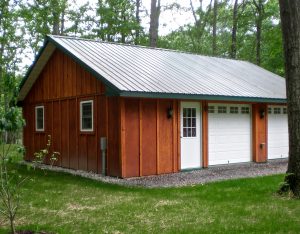Do a Google search for board and batten siding images, and what usually comes up are old leaning barns. Board and batten has often been associated with the term “rustic” as well.

OLYMPUS DIGITAL CAMERA
Typical “old tyme” board and batten was created by installing 1” (or even 5/4”) x12” planks vertically over horizontal wall framing (girts). The seams between each 1×12 are then covered by a vertical 1 inch thick board (the batten), running in width anywhere from 1-1/2” to 5-1/2”. In some cases, widths of battens are staggered on alternate seams, to create a less standardized look.
My neighbor to the east (our second home in Washington) has a summer cabin built using board and batten siding for exterior walls. Taken to an extreme, this cabin has no stud walls, the boards are attached to the floor and ceiling only. Yes, I know…pretty scary considering today’s framing designs. The inside of these walls look remarkably like the outside. Obviously this particular design left no wall cavity for things like electrical or insulation, but when built in the 1930’s, those features were not a consideration.
Buildings need to have the ability to withstand shear loads – in simple terms, keeping the building from “racking” (straining or stretching) due to either wind or seismic loads. As Google images brings up a plethora of “old leaning barns”, it leads one to believe the board and batten system may be less than effective in resisting these loads. Not so…if you “do it right”.
For years, I’ve made several recommendations to those who insisted upon getting the board and batten look.
The most popular is the use of sheets (panels) of rough faced (no grooves) T1-11 or cement based siding, instead of the boards. Either is going to prove far less expensive and affords the ability to structurally withstand most shear loads.
For those who just “must have boards”, my opinion is to install them over either osb (oriented strand board) or cdx plywood to give the best end result.
I’ve also had standing seam steel used over sheathing which creates the same look as board and batten siding, and with greater durability.
Never have I recommended the use of board and batten siding placed directly over wall girts…or walls with housewrap. I just have never felt this was a good structural solution.
Late in 2011, Hansen Pole Buildings had a builder insist upon using 1×6 cedar boards with 1×3 cedar battens as the structural sheathing for a pole barn. The International Building Codes do allow for the use of one inch thick boards placed diagonally as structural sheathing in Chapter 23; however make no mention of the adequacy of boards placed at 90 degrees to the underlying framing. From research I found “Seismic Rehabilitation of Existing Buildings” by ASCE (American Society of Civil Engineers) has a value for shear in this application.
In Table 8-2 Default Expected Strength Values for Wood Diaphragms, “Single Straight Sheathing is given an expected strength of 120 plf. It might be interesting to note, this is only 20% of the value of a single layer placed diagonally.
As a matter of installation, end joints of adjacent boards should be separated by at least one joist space and there should be at least two boards between joints on the same support. The boards should be nailed with three 8d common nails to each supporting member.
While I do not necessarily support this method of siding installation as the best possible structural solution, the numbers can be run to verify… it does indeed work.






